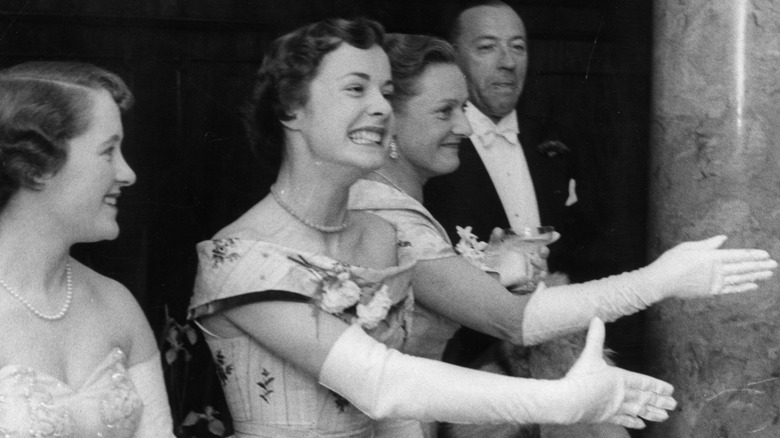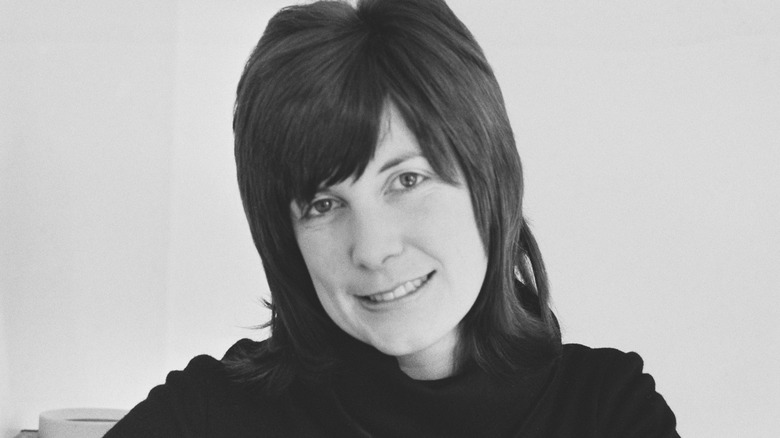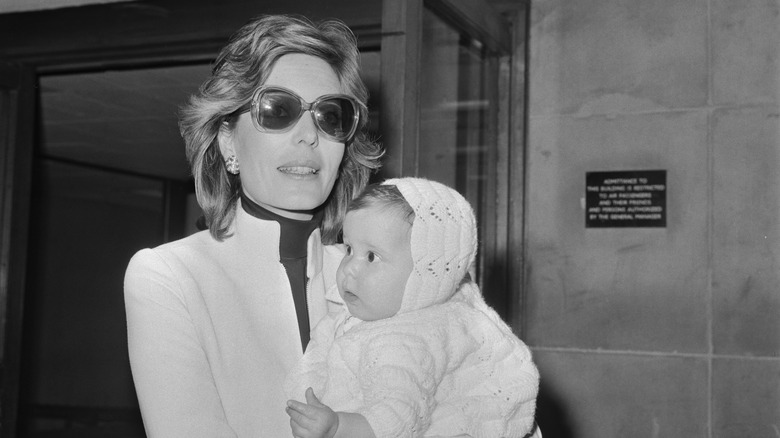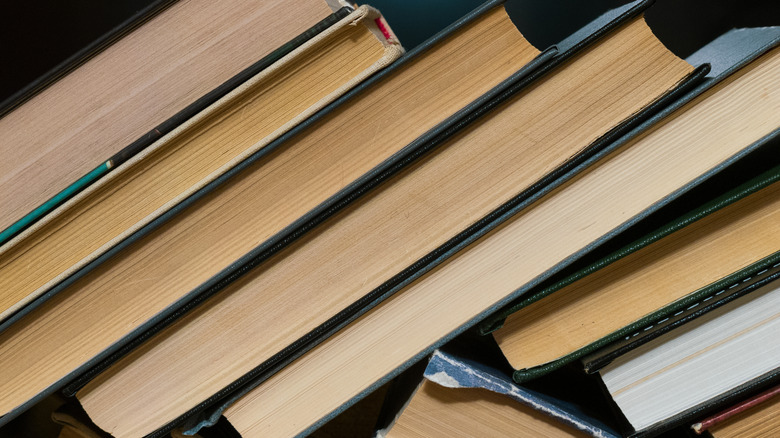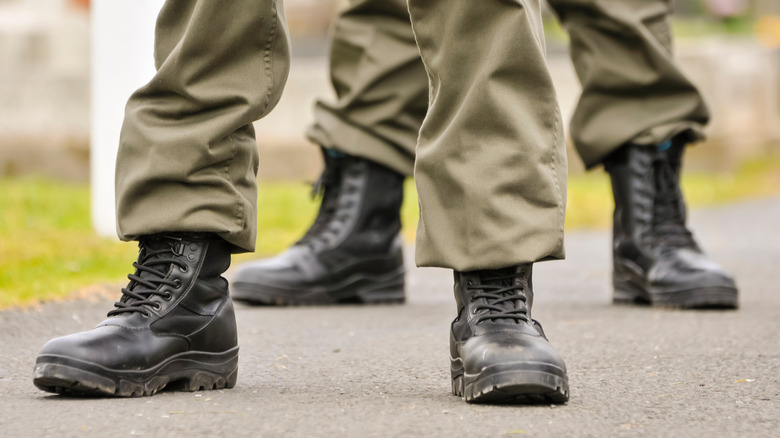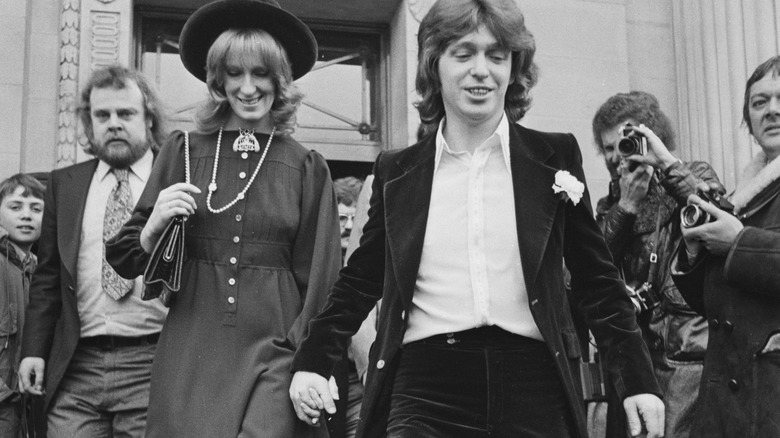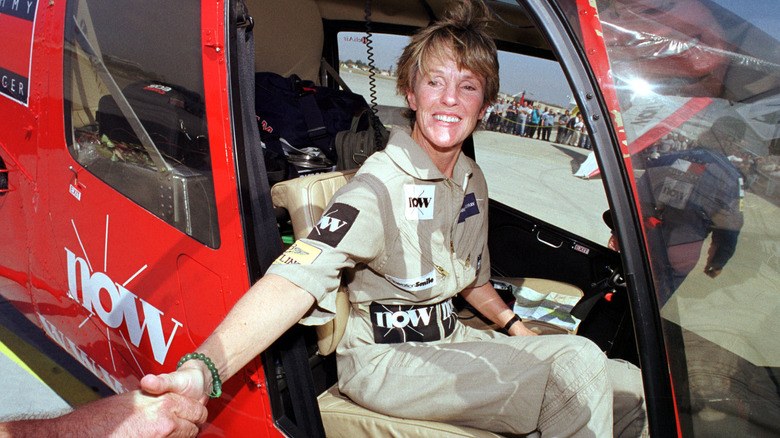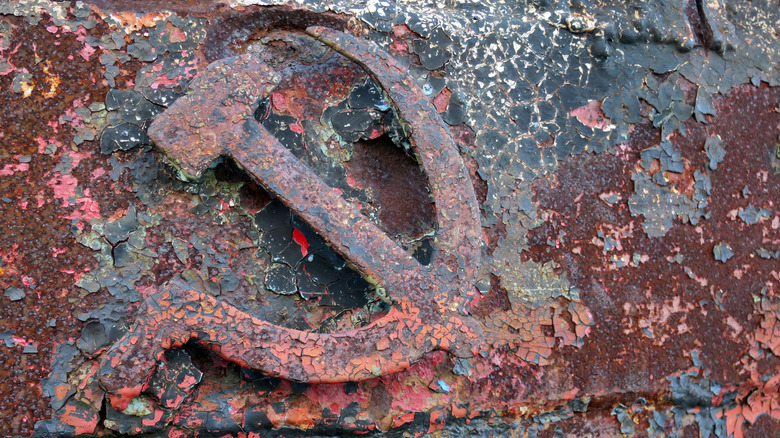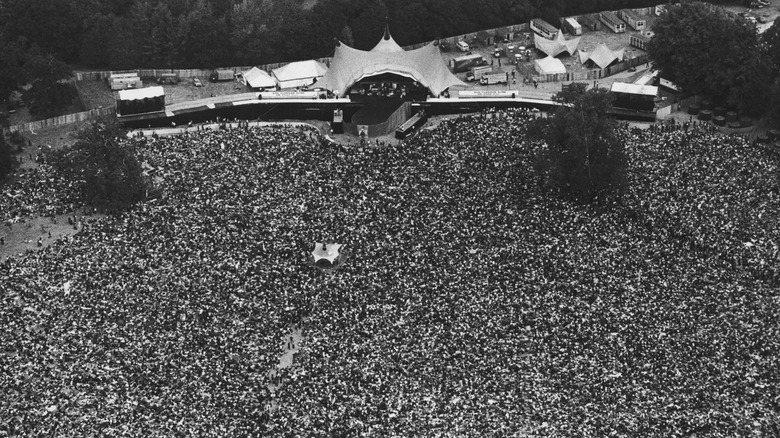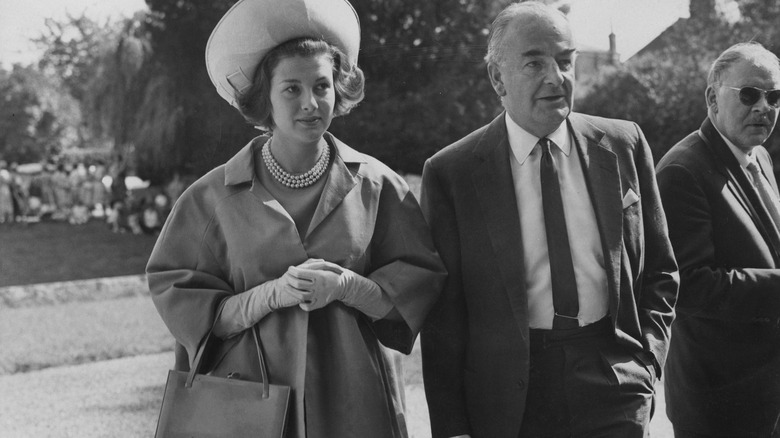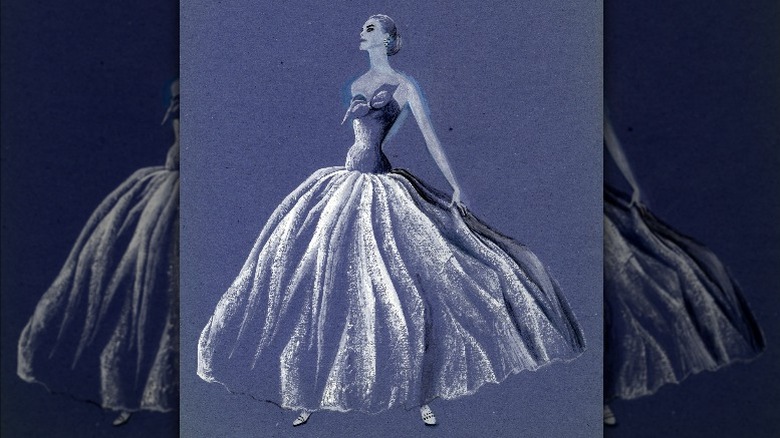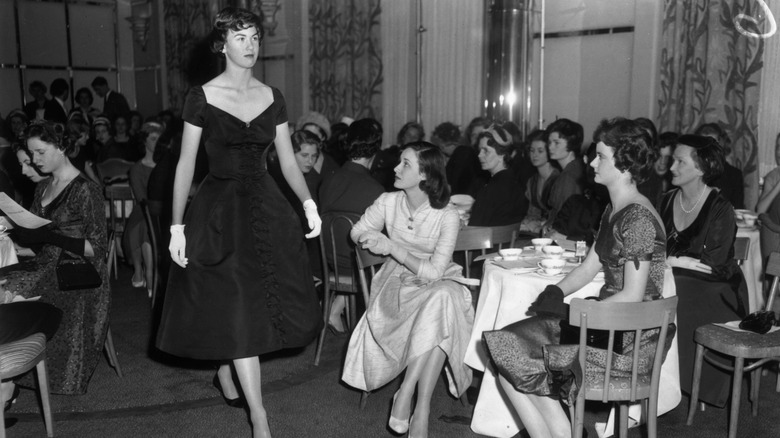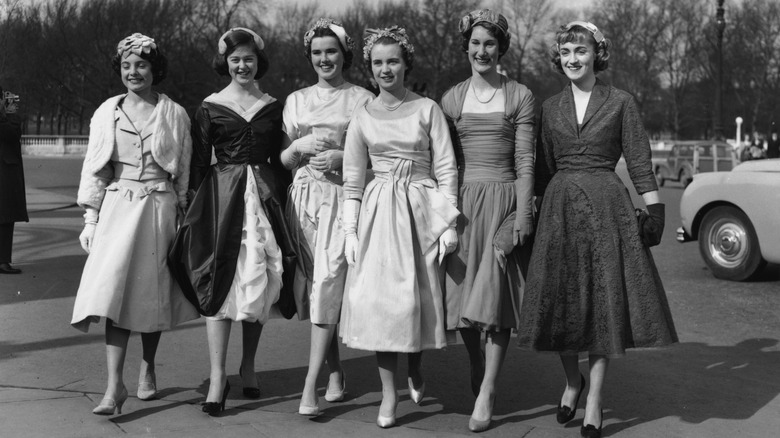These Were The Last Debutantes Presented To The Queen
Netflix's smash hit "Bridgerton" has charmed fans the world over at introduced many viewers to the idea of debutantes and debutante balls. At the heart of the story are eight siblings caught up in life at the British Georgian court during the debutante season as Queen Charlotte prepares to name the next "diamond of the first water" (via History Extra). In this world of rigorous social protocols, we find a host of diverse debutantes presumably on the hunt for husbands.
But how much real-life history is there in this world of glittering ballrooms, impeccable manners, and stunning costumes? You may be surprised to find out that the practice of presenting debutantes to the English monarch continued into the mid-20th century, per Country Life.
The last debutantes curtseyed before the Queen in 1958. While some of the women used this time to snatch up husbands, others went on to college and careers in various fields ranging from editing to aerospace. Here are some of their fascinating stories as the last participants in a 2-century-old tradition.
Fiona MacCarthy
In the spring and summer of 1958, the last debutantes curtseyed to the British monarch, and Fiona MacCarthy stood among them, as reported by Country Life. As one of the so-called four "bluestocking debs," MacCarthy had already broken from the typical debutante mold. "Bluestocking debs" referred to those women who decided to go on to college after finishing the season, and she had plans that extended well beyond clinching a great marriage prospect.
As a woman with a future not exclusively defined by domesticity, she recalls, "We were in the minority, although I'm surprised that so many debs I talk to today shared my reservations about having our futures — marriage and so on — mapped out for us." While MacCarthy may have felt somewhat alone based on her future ambitions, she came before the British royal family in a group numbering four or five hundred, according to History Extra. All told, 1,400 debs got presented that last year.
Despite the somewhat archaic nature of the debutante season, she remembers it fondly and nostalgically because it indeed marked the end of an era. She also found it impossible to participate in the events of that season without reflecting on how it all began in honor of Queen Charlotte in 1780, per Insider. These thoughts back to a storied past would help MacCarthy write the book "Last Curtsey: The End of the Debutantes."
Sally Croker-Poole
Another familiar face during the last debutante season was Sally Croker-Poole, who came from an Indian Army family, per Fiona MacCarthy's "Last Curtsey: The End of the Debutantes." With the South Asian nation's celebration of independence in 1947, her father, Colonel Croker-Poole, returned with his family to the United Kingdom, taking up a job at Scotland Yard that the family largely kept under wraps.
Her mother, Mrs. Croker-Poole, perfected the art of barring the competition, always finding clever ways to put her daughter in front of Britain's most eligible bachelors. Her ambitions reached sky-high when it came to marrying off her daughter, and they wouldn't go unrewarded. Sally Croker-Poole worked as a model before marrying Lord James Crichton-Stuart, an English member of the nobility (via the Independent). They tied the knot in a posh ceremony at the Italianate Brompton Oratory in London.
While the match likely put her mother over the moon, Croker-Poole soon threw convention to the wind, per Julia Kelly's "The Last Dance of the Debutante." A chance meeting with Prince Karim Aga Kahn led to an illicit romance, divorce, and second marriage, requiring her conversion to Islam. She enjoyed audacious wealth until 1994, when his dilly-dallying proved unbearable. So, she divorced him, sold the $25 million collection of jewels he'd given her, and moved on with Phillipe Lizop, her divorce attorney. She also threw herself into working with charities supporting child welfare.
Auriol Stevens
Another of the "bluestocking debs," as the gossip columns of newspapers disparagingly called them, was Auriol Stevens, per Fiona MacCarthy's "Last Curtsey: The End of the Debutantes." She'd passed her Oxford exam and had both brains and beauty with auburn hair, a willowy figure, and graceful movements. Stevens recalls staying up in the evening sewing gowns with her mother (via Country Life). But her desire to do more than get married attracted press attention.
She, like Fiona MacCarthy, lived in a period when women remained relegated to the metaphoric pretty shelf. It was still frowned upon for them to weigh in on politics and other intellectual matters in the most elite social circles. Of course, these expectations also cut women out of positions in the academic sphere. But despite these challenges, Stevens bucked the trends that some other debs bowed to.
Following her days as a debutante, Stevens enjoyed a career of great intellectual acclaim. She worked as the education correspondent for the Observer and as a journalist for "A Week in Politics," a British television program. She would eventually become the editor of the "Times Higher Education Supplement," too.
Rose Dugdale
Rose Dugdale's father, Eric Dugdale, owned a 600-acre estate near Axminster and worked as a Lloyd's underwriter, per Fiona MacCarthy's "Last Curtsey: The End of the Debutantes." Carol Dugdale, her mother, was heiress to a soap-making family in Liverpool. The other debutantes recall Rose Dugdale as generous, witty, and the life of the party. But MacCarthy also remembers the Dugdale household as one of strict rules reigned over by the unbending and intimidating Carol Dugdale.
Some in the press would later claim this rigorous upbringing contributed to Rose Dugdale's shocking rebellion as a high-profile IRA fighter (per the Independent). After attending Oxford and earning a doctorate in economics, she abandoned her elite lifestyle for one of rebellion and criminality. Crime Reads reports she led a series of politically-inspired art thefts, including the seizure of a Vermeer from Russborough House.
These burglaries clinched her reputation as one of the most successful art thieves in history. She stole the paintings to negotiate the release of two Irish sisters held on explosives charges, Marion and Dolours Price. Predictably, she would do time in prison for the art thefts, pleading "proudly and incorruptibly guilty" in court. She received a 9-year sentence and served six years, giving birth to a son while in the slammer. She also married the baby's father, Eddie Gallagher, a noted IRA terrorist, while behind bars, although the marriage wouldn't endure as long as her deb-turned-hell-raiser reputation.
Nicolette Harrison
Nicolette Harrison enjoyed the first engagement among the debutantes of 1958, per Fiona MacCarthy's "Last Curtsey: The End of the Debutantes." The daughter of a Lloyd's underwriter and a baroness from Latvia, her family announced her betrothal to Alexander Vane-Tempest, the Marquess of Londonderry, just 10 days into the season. As MacCarthy notes, this made the balls of 1958 irrelevant to the young beauty who spent her time planning the "wedding of the season."
Their nuptials took place at one of Wiltshire's parish churches. Before they knew it, the couple had welcomed two children to their posh estate at Wynyard Hall, considered by many the most opulent mansion house in the region (via The Northern Echo). But if you assume this marks Harrison's happy ending, you're in for a surprise.
After the marchioness and her husband had a son who became Viscount Castlereagh, Vane-Tempest harbored suspicions. A blood test soon confirmed (per the Express) that the alleged heir to the Londonderry title was actually the son of pop star Georgie Fame (Clive Powell). After a divorce in 1971, Harrison and Fame wed, and their son dropped the noble title. They soon had a second son and appeared the picture of contentment. But in 1993, Harrison died by suicide, as reported by the Independent. A formal investigation revealed details about her depression related to severe empty nest syndrome.
If you or anyone you know is having suicidal thoughts, please call the National Suicide Prevention Lifeline at 1-800-273-TALK (8255).
Jennifer Murray (née Mather)
Like the other last debutantes, Jennifer Murray curtseyed to the Queen in 1958, as reported by Julia Kelly in "The Last Dance of the Debutante." Following her ballroom days, she became the first woman to pilot around the world in a helicopter. In 1997, she completed the trip in 97 days, accompanied by her co-pilot, Quentin Smith, per FAI Global Partners. Most impressively, she completed the feat with just three years of flying and 600 hours of airtime under her belt.
But this marked just the beginning when it came to her record-breaking aerial exploits. In 2000, she repeated her circumnavigation of the globe, becoming the first woman to do so solo. She also broke the record for completing the trip without autopilot. In 2003, she and co-pilot Colon Bodill became the first flying duo to take a helicopter to the South Pole, which nearly resulted in their deaths after a crash during an Antarctic blizzard.
Not to be outdone, Murray pushed the record-breaking flying yet again in 2006 and 2007. Teaming up with Bodill once more, the pair became the first crew in history to circumnavigate the globe flying over the North and South Poles. She would go on to write about her incredible adventures, authoring three books about her flights.
Teresa Hayter
Rose Dugdale wouldn't be the only woman among the debutantes to become embroiled in radical politics, according to the Independent. Following her debutante days, Teresa Hayter's life changed irrevocably after becoming indoctrinated in Marxist ideology. In "Last Curtsey: The End of the Debutantes," Fiona MacCarthy refers to the night-and-day transformation Hayter underwent as an "almost total cut-off between her old life and her new."
This seismic political shift alienated those closest to her. But she soon flourished as the author of many works about economics and social justice topics. Her books explored meaty themes like global piracy, environmental exploitation, and world poverty. And she did more than merely talk the talk when it came to issues impacting the most financially vulnerable members of the world community. She also walked the walk.
In 1988, she participated in protests at the Rover Group's Cowley car plant. This closure devastated the region, causing a massive uptick in joblessness. Later, she protested a detention center for illegal immigrants in 1993 at Campsfield. She followed this with the book "Open Borders," which challenged status quo immigration policies in the United Kingdom. Pounding the pavement on behalf of illegal immigrants and the unemployed appears to suit Hayter despite it being a far cry from a youth spent filling dance cards during the season of 1958.
Christine Stucley
Another renowned beauty who came out in 1958 and curtseyed before the Queen was Christine Stucley. According to the Independent, she still remembers the outfit that first won the attention of her future husband, heir to Hertfordshire's Knebworth House, David Cobbold. A revealing green number, she wore it with her hair down, inspiring Cobbold to ask, "Are you a mermaid?" The rest was history.
But marriage proved just the start for this dynamic duo. The Cobbolds worked tirelessly to renovate Knebworth House, a structure dating to the Elizabethan era. As you can imagine, it came with all the problems of a centuries-old manor. Yet, the couple not only successfully updated the property but then decided to share it with the world.
They did so by creating the iconic Knebworth rock festival, which has boasted headliners ranging from Led Zeppelin to the Rolling Stones, Pink Floyd, Oasis, and more (via the Welwyn Hatfield Times). The Cobbolds held their first concert in 1974, proving a smashing success. Five decades later, Knebworth Park remains the largest music venue in Great Britain and one of the most beloved.
Diane Kirk
As one of the last debutantes, Diane Kirk initially hoped the exposure she received during the season would help launch her career as a film star, as reported by the Independent. But life had other plans for her. In 1958, she did a turn modeling for Pierre Cardin. In one of her most famous photos from the shoot, she stood in front of a painting by Gainsborough in a glittering gold frame.
The following year, she raised eyebrows with her choice of husband, Earl Beatty. At 54, Beatty had already been married three times and was old enough to be her father (and almost her grandfather). While some might have assumed this match would bring her ambitions to an end, the opposite proved true. Beatty encouraged her to explore her talents and interests, marking the beginning of a high-profile career.
She was elected to the Westminster Council and later served as the first woman on the board of Anglia TV for six years between 1991 and 1997. She also worked with the National Heritage Memorial Fund as a trustee. Next, came a stint chairing the Georgian Group and the Drawing School of the Prince of Wales. The former star of gossip columns soon occupied a significant role in the world of cultural politics.
Maggie MacKay
During the 1958 debutante season, Maggie MacKay became close friends with Elfrida Eden (Fallowfield), and they've remained tight-knit ever since, according to the BBC. MacKay remembers the many responsibilities and full wardrobe associated with being a debutante. At a bare minimum, she had to have several ballroom gowns, always ready to go at a moment's notice.
Of course, that was just the beginning when it came to the looks necessary to keep up with the many engagements of the season. MacKay also recounts having numerous cocktail dresses, suitable clothes for lunch and teas, and matching hats and gloves for everything. But while looks mattered, she also felt participating in the debutante season was more of a rite of passage than simply a hunt for a husband. This expectation stemmed from how her mother looked at the significance of being a debutante. As MacKay explains, "My mother was keen for me to just meet people, it didn't matter about the sex of them, and she certainly didn't want to marry me off at 18" (via the BBC).
While the debutante season proved highly glamorous, MacKay also remembers it as very exhausting. Debutantes often attended multiple events on the same night where all eyes were on them. They had to keep up appearances under the microscopic lens of high society with few breaks to act like typical teens.
Elfrida Eden
Elfrida Eden remembers looking forward to the last debutante season, which kept her busy with dances, dinners, and various social engagements (via the BBC). She also notes it helped her grow up and learn good etiquette and manners. But she says she and Maggie MacKay didn't meet their husbands during the season. Instead, they each went on to date many men before settling down. In the case of Eden, she would eventually tie the knot with Richard Fallowfield, an advertising executive in New York, per the Express.
Like her friend MacKay, Eden also saw the debutante season as an educational experience rather than a manhunt. Reflecting back, she realizes how it helped her mature and interact in the adult world. In an interview with the BBC, she likened it to a "gap year" today, where young men and women take time off for travel, volunteering, or other activities before settling into adulting.
While she can't help but reflect on how anachronistic the whole tradition looks today, she also remains happy that she had the chance to experience life as a debutante. "We knew it was the last season, and it felt special. I was by no means the last girl to be presented to the Queen that day, but I was the last person down the staircase at the Palace. I wanted to savor every moment" (via the Express).
Sandra Seagram
History tells us that the last debutante, Sandra Seagram, presented at Buckingham Palace to the royal family, curtseyed to the Queen Mother and Prince Philip, Duke of Edinburgh on July 17, 1958 (via Ottawa City News). Unfortunately, Queen Elizabeth II couldn't attend due to illness. Seagram, a 20-year-old Canadian, came from a storied line as the great-granddaughter of Joseph Emm Seagram who created the Seagram Whiskey brand after constructing a distillery in Waterloo, Ontario, Canada, according to History Extra.
Seagram filled big shoes, following in the tradition of her mother and grandmother who had also gone through the debutante season in their youths. She also marked one of 40 girls from Canada who had traveled to the headquarters of the British Commonwealth for this soon-to-be antiquated event.
The last debutante would meet and marry Dr. Eugenio Annovazzi in 1959, and the couple settled in Italy, according to The Record. They would have two children and raise them in Italy although they kept their mother's maiden name before their surnames. Like the other debutantes that came before Britain's mid-century nobility, Seagram remained distinctly aware that she was the last in a tradition stretching back for centuries. Yet, she and her fellow debutantes couldn't deny that the "times they [were] a-changin'" to borrow a line from Bob Dylan. The colorful and diverse lives of the last debutantes epitomize just how great these changes would be.
